Flatworms (Phylum Platyhelminthes) are unsegmented worms with soft and bilaterally symmetrical bodies. They are generally rather flat, and hence the common name "flatworm". The name "Platyhelminthes" originated from the Greek words "platy" (meaning "flat") while "helmins" (meaning "worm").

The flat body allows internal transportation of oxygen and nutrients by diffusion, since most of them do not have a body cavity, circulatory organ and respiratory organ (except for some larger species). They still possess a simple brain though at their front end, and lateral nerve chords. Hence, some scientists are studying their simple brains, so as to understand our more complex brains better.
Flatworms have an incomplete digestive system, and the mouth is used for both ingestion and excretion. Most of them are hermaphrodites, meaning that each flatworm possesses both male and female reproductive organs. When they mate, one flatworm may play the male's role, while the other the female's role, though in some cases they may fertilise each other.

Flatworms also have an amazing ability to regenerate loss body parts. It is not uncommon to see those with part of their flat body bitten off by predators and still surviving well. Many species hence can also reproduce asexually by fission – splitting into two and regenerating the missing parts. Many flatworms are parasites of other animals, either infesting them internally or attached to them externally. Examples of parasitic flatworms include tapeworms, flukes and monogeneans. But apart from them, there are many free-living species too, and these beautiful worms can be seen sometimes in our forests and seashores.
Singapore has several species of terrestrial flatworms that are mostly found in damp areas, as most of them are unable to retain water in their body. These terrestrial flatworms are voracious predators of earthworms, possessing a reversible muscular structure called a pharynx, which they use to grab their prey. They will then secrete enzymes to digest the prey externally, before eating the processed meal. Like other flatworms, terrestrial flatworms can reproduce sexually or asexually. Scientifically, the terrestrial flatworms found in Singapore are from the class Turbellaria and order Tricladida. These are some of the terrestrial flatworms that I have seen:
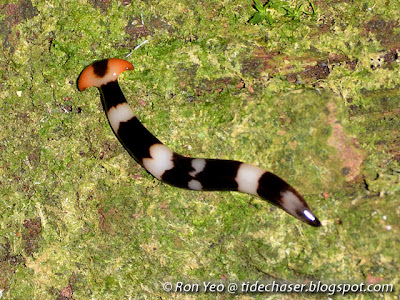
This Bipalium sp. is often seen in our forests or even scrublands.

This is also a Bipalium sp. It has an orange head, somewhat like the previous species, but has a black line running on its back. The body is relatively longer compared to the head also.

This Bipalium sp. has black and white bands on its body, but lacks the orange coloration found in the previous species on its head.

This Bipalium sp. has a few cream-coloured patches on its body.
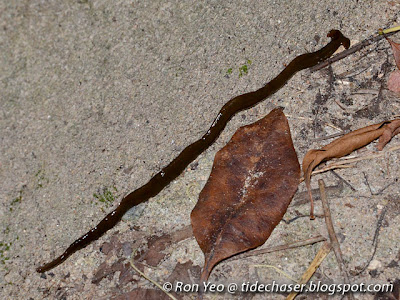
This Bipalium sp. is all brown in colour.

This is likely a Dolichoplana sp. It is sometimes seen in our forest.

This is an unknown species of terrestrial flatworm that is sometimes seen on trees.
Free-living flatworms are also found in the marine environment. They are also called "polyclads", which means "any branches", referring to the highly branched guts radiating from their mouths. Scientifically, marine flatworms are placed in the class Turbellaria, and order Polycladida. As marine flatworms are usually very flat, they are very fragile and get torn easily. But been flat also allows them to slide into narrow cracks and crevices to seek prey and escape predation. Like other flatworms, they are mostly carnivorous, and usually feed on sessile organisms such as tunicates and bryozoans. Some may feed on motile organisms too, such as some worms and crustaceans, while others may scavenge. Only a few are herbivorous, feeding on algae. The mouth is on the underside, and may be located near the front end, in the middle or even near the rear end, depending on the species. Like the terrestrial flatworms, they have a pharynx for feeding.

Many bigger polyclads can swim by flapping the sides of their bodies.
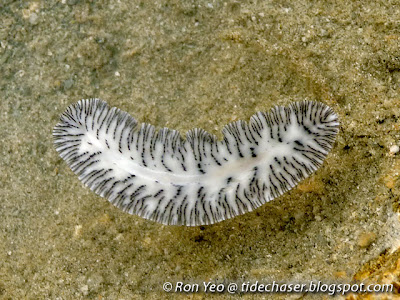
Others can glide upside-down on the surface of the water.
Marine flatworms have brilliant colours to advertise their toxicity to predators. Studies have shown that many species contain powerful nerve toxins in their tissues, making them poisonous to most animals.
Like other flatworms, they are hermaphrodites, and some polyclads indulge in what is termed 'penis fencing'. Each flatworm extends its male reproductive organ to attempt fertilising the other party while avoiding getting itself fertilised by the latter, as egg production consumes more energy and resources. This results in a fierce fight between the two flatworms, and the "winner" just need to pierce the "loser's" skin with its penis, and the sperm will be absorbed through pores of the other party.
As the flatworms in Singapore are generally not well-studied, the identities are usually derived by comparing with identification guides and hence are rather tentative. Many of them, are in fact, not even tentatively identified. Some of the marine flatworms which I have seen and photographed include:

This flatworm is sometimes found sliding over the rocks on rocky shores during low tide. It is likely that it hides in trapped pockets of air among cracks and crevices during high tide, or even in crevices above the high tide line, since it does not appear to like water. I still could not determine what species it is from the guide books and online resources though.

This Mangrove Flatworm (Limnostylochus sp.) appears to be seasonally abundant, as there are times when literally hundreds of them can be seen, while at other times, none can be seen at all. They usually occur in mangroves, especially nearer to the back mangroves in brackish water. It is usually dark red with a thin orange line on its back.
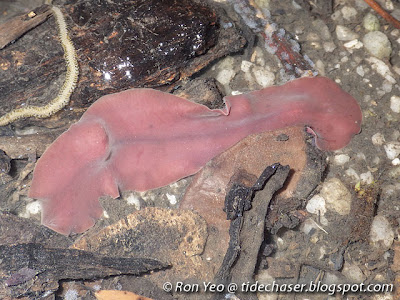
This unknown flatworm is also found in the mangroves. It is pink in colour, and lacks the thin line found on the back of the previous species.

The Acanthozoon Flatworm (Acanthozoon sp.) is one of the most commonly seen flatworm in Singapore. It can grow to more than 10cm long, and is certainly one of the biggest flatworms found here. Despite being a commonly seen species in the region, it has not been described scientifically and hence still does not have a species name. This flatworm has numerous small yellow spots and a few bigger white spots on a black background with a narrow white margin.
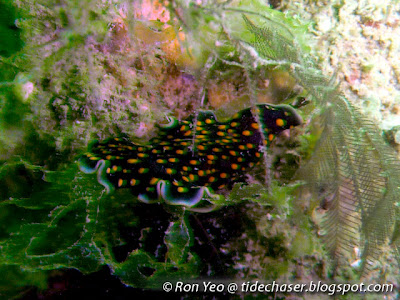
The Thysanozoon Flatworm (Thysanozoon sp.) is usually found in deeper waters, and hence are seldom encountered in the intertidal zones. They are sometimes seen while diving in local waters. Like the previous flatworm, it has numerous yellow spots on a black background with white borders, but the yellow spots are bigger and it does not have the bigger white spots.

The ID of this species is still under investigation. It has numerous black and blurry lines extending from the middle. A red line, sometimes dotted, runs down its back in the middle.

Maritigrella fuscapunctata also has numerous black blurry lines on the sides, but lacks the red line found on the back of the previous species.

Phrikoceros baibaiye is red or bright orange in colour, dotted with numerous tiny white spots.

The Orsak's Flatworm (Maiazoon orsaki) is sometimes seen in the intertidal area on Singapore's southern islands. It is orange or brown with a white line running along the middle of its back, and the colour darkens towards the edge of the mantle, followed by a narrow black border.

A rather similar-looking species is Nymphozoon bayeri, which usually has a broad brown, grey or black line on its back. The colour appears to be rather variable, but it generally has a black border.

The Bedford's Flatworm (Pseudobiceros bedfordi) is a very pretty flatworm that is sometimes seen on our shores. The patterns on its back is much like some Persian carpet or batik design, with black-and-white spotted branching designs on an orange background.

This flatworm's ID is also underinvestigation. It is also seasonally abundant, and I have once seen large numbers of them in the seagrass meadow of Kusu Island. They are usually brown or dark brown in colour with numerous whitish spots and small patches and a thick black border.

Here is another one of a slightly darker colour tone.

Pseudobiceros uniarborensis is another often seen flatworm. It is black in colour, followed by an orange border then a thin white border right at the edges.
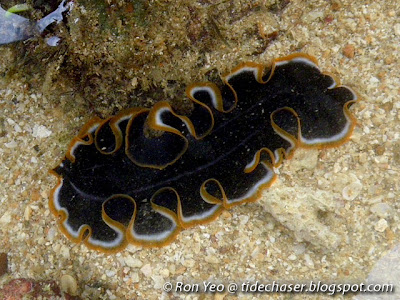
A similar-looking flatworm is this one, which is also black, but has a white border followed by an orange border right at the edges. This flatworm is still unidentified.

This flatworm is white with blue edges, and has three black-bordered yellow stripes running along its back. Its identity is currently still under investigation.

This flatworm is tentatively identified as Pseudoceros laingensis, and it usually has many purple dots on its back, and a purple-dotted border.

In some online resources, this Pseudoceras sp. was tentatively identified as Pseudoceros laingensis as well, but it has a blue-spotted border and no spots on the middle of its back. Other resources identified it tentatively as Pseudoceros indicus.

This is another variation which the blue dots are more closely-packed. It should be Pseudoceros indicus.

This small flatworm is sometimes seen on our shores. It resembles Pseudoceros bifurcus, but the latter has a white line with a red tip on its back, while this individual has a yellow line with a somewhat orange tip, both on a blue background. No sure if they are of the same species, but more obvious specimens of Pseudoceros bifurcus do occur in local waters, though I do not have the photos.

This is another similar-looking one, but is more whitish in colour with blue edges. There are numerous small white patches on the back as well.

This flatworm also has many small white patches on a light grey background, and a blue border. However, it has a blue line running along its back. It is still unidentified.

A similar-looking one will be this flatworm which last the small white patches, but generally has a blue line running along its back in the middle, and a blue border on a whitish background. It is also unidentified.

Another unidentified flatworm will be this black flatworm, which when closely examined is covered with tiny white dots.

This greenish-yellow, or olive-coloured flatworm is also not yet identified, though it can be easily seen on some of our shores. The colour usually darkens toward the edges, and it has a thin black border follow by a thin white border right at the edges.
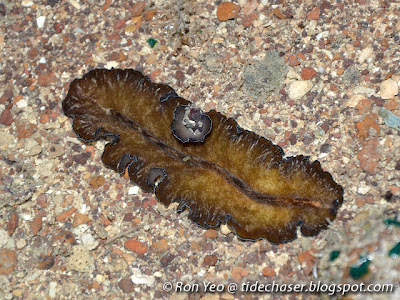
This is possibly a colour variation of the same species. It is somewhat brownish-yellow, but similarly the colour darkens toward the edges and has the black followed by white border at the edges.
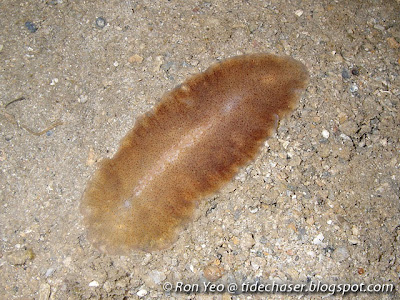
I have only seen this unidentified translucent flatworm once. It has numerous brown dots on it.

This striped flatworm somewhat resembles the striped variety of Pseudobiceros fulgor. I have checked across many resources, but the latter species appears to have many variations, and I suspect some of the identifications may be wrong. As such, this is also unidentified for now.
References

The flat body allows internal transportation of oxygen and nutrients by diffusion, since most of them do not have a body cavity, circulatory organ and respiratory organ (except for some larger species). They still possess a simple brain though at their front end, and lateral nerve chords. Hence, some scientists are studying their simple brains, so as to understand our more complex brains better.
Flatworms have an incomplete digestive system, and the mouth is used for both ingestion and excretion. Most of them are hermaphrodites, meaning that each flatworm possesses both male and female reproductive organs. When they mate, one flatworm may play the male's role, while the other the female's role, though in some cases they may fertilise each other.

Flatworms also have an amazing ability to regenerate loss body parts. It is not uncommon to see those with part of their flat body bitten off by predators and still surviving well. Many species hence can also reproduce asexually by fission – splitting into two and regenerating the missing parts. Many flatworms are parasites of other animals, either infesting them internally or attached to them externally. Examples of parasitic flatworms include tapeworms, flukes and monogeneans. But apart from them, there are many free-living species too, and these beautiful worms can be seen sometimes in our forests and seashores.
Singapore has several species of terrestrial flatworms that are mostly found in damp areas, as most of them are unable to retain water in their body. These terrestrial flatworms are voracious predators of earthworms, possessing a reversible muscular structure called a pharynx, which they use to grab their prey. They will then secrete enzymes to digest the prey externally, before eating the processed meal. Like other flatworms, terrestrial flatworms can reproduce sexually or asexually. Scientifically, the terrestrial flatworms found in Singapore are from the class Turbellaria and order Tricladida. These are some of the terrestrial flatworms that I have seen:

This Bipalium sp. is often seen in our forests or even scrublands.

This is also a Bipalium sp. It has an orange head, somewhat like the previous species, but has a black line running on its back. The body is relatively longer compared to the head also.

This Bipalium sp. has black and white bands on its body, but lacks the orange coloration found in the previous species on its head.

This Bipalium sp. has a few cream-coloured patches on its body.

This Bipalium sp. is all brown in colour.

This is likely a Dolichoplana sp. It is sometimes seen in our forest.

This is an unknown species of terrestrial flatworm that is sometimes seen on trees.
Free-living flatworms are also found in the marine environment. They are also called "polyclads", which means "any branches", referring to the highly branched guts radiating from their mouths. Scientifically, marine flatworms are placed in the class Turbellaria, and order Polycladida. As marine flatworms are usually very flat, they are very fragile and get torn easily. But been flat also allows them to slide into narrow cracks and crevices to seek prey and escape predation. Like other flatworms, they are mostly carnivorous, and usually feed on sessile organisms such as tunicates and bryozoans. Some may feed on motile organisms too, such as some worms and crustaceans, while others may scavenge. Only a few are herbivorous, feeding on algae. The mouth is on the underside, and may be located near the front end, in the middle or even near the rear end, depending on the species. Like the terrestrial flatworms, they have a pharynx for feeding.

Many bigger polyclads can swim by flapping the sides of their bodies.

Others can glide upside-down on the surface of the water.
Marine flatworms have brilliant colours to advertise their toxicity to predators. Studies have shown that many species contain powerful nerve toxins in their tissues, making them poisonous to most animals.
Like other flatworms, they are hermaphrodites, and some polyclads indulge in what is termed 'penis fencing'. Each flatworm extends its male reproductive organ to attempt fertilising the other party while avoiding getting itself fertilised by the latter, as egg production consumes more energy and resources. This results in a fierce fight between the two flatworms, and the "winner" just need to pierce the "loser's" skin with its penis, and the sperm will be absorbed through pores of the other party.
As the flatworms in Singapore are generally not well-studied, the identities are usually derived by comparing with identification guides and hence are rather tentative. Many of them, are in fact, not even tentatively identified. Some of the marine flatworms which I have seen and photographed include:

This flatworm is sometimes found sliding over the rocks on rocky shores during low tide. It is likely that it hides in trapped pockets of air among cracks and crevices during high tide, or even in crevices above the high tide line, since it does not appear to like water. I still could not determine what species it is from the guide books and online resources though.

This Mangrove Flatworm (Limnostylochus sp.) appears to be seasonally abundant, as there are times when literally hundreds of them can be seen, while at other times, none can be seen at all. They usually occur in mangroves, especially nearer to the back mangroves in brackish water. It is usually dark red with a thin orange line on its back.

This unknown flatworm is also found in the mangroves. It is pink in colour, and lacks the thin line found on the back of the previous species.

The Acanthozoon Flatworm (Acanthozoon sp.) is one of the most commonly seen flatworm in Singapore. It can grow to more than 10cm long, and is certainly one of the biggest flatworms found here. Despite being a commonly seen species in the region, it has not been described scientifically and hence still does not have a species name. This flatworm has numerous small yellow spots and a few bigger white spots on a black background with a narrow white margin.

The Thysanozoon Flatworm (Thysanozoon sp.) is usually found in deeper waters, and hence are seldom encountered in the intertidal zones. They are sometimes seen while diving in local waters. Like the previous flatworm, it has numerous yellow spots on a black background with white borders, but the yellow spots are bigger and it does not have the bigger white spots.

The ID of this species is still under investigation. It has numerous black and blurry lines extending from the middle. A red line, sometimes dotted, runs down its back in the middle.

Maritigrella fuscapunctata also has numerous black blurry lines on the sides, but lacks the red line found on the back of the previous species.

Phrikoceros baibaiye is red or bright orange in colour, dotted with numerous tiny white spots.

The Orsak's Flatworm (Maiazoon orsaki) is sometimes seen in the intertidal area on Singapore's southern islands. It is orange or brown with a white line running along the middle of its back, and the colour darkens towards the edge of the mantle, followed by a narrow black border.

A rather similar-looking species is Nymphozoon bayeri, which usually has a broad brown, grey or black line on its back. The colour appears to be rather variable, but it generally has a black border.

The Bedford's Flatworm (Pseudobiceros bedfordi) is a very pretty flatworm that is sometimes seen on our shores. The patterns on its back is much like some Persian carpet or batik design, with black-and-white spotted branching designs on an orange background.

This flatworm's ID is also underinvestigation. It is also seasonally abundant, and I have once seen large numbers of them in the seagrass meadow of Kusu Island. They are usually brown or dark brown in colour with numerous whitish spots and small patches and a thick black border.

Here is another one of a slightly darker colour tone.

Pseudobiceros uniarborensis is another often seen flatworm. It is black in colour, followed by an orange border then a thin white border right at the edges.

A similar-looking flatworm is this one, which is also black, but has a white border followed by an orange border right at the edges. This flatworm is still unidentified.

This flatworm is white with blue edges, and has three black-bordered yellow stripes running along its back. Its identity is currently still under investigation.

This flatworm is tentatively identified as Pseudoceros laingensis, and it usually has many purple dots on its back, and a purple-dotted border.

In some online resources, this Pseudoceras sp. was tentatively identified as Pseudoceros laingensis as well, but it has a blue-spotted border and no spots on the middle of its back. Other resources identified it tentatively as Pseudoceros indicus.

This is another variation which the blue dots are more closely-packed. It should be Pseudoceros indicus.

This small flatworm is sometimes seen on our shores. It resembles Pseudoceros bifurcus, but the latter has a white line with a red tip on its back, while this individual has a yellow line with a somewhat orange tip, both on a blue background. No sure if they are of the same species, but more obvious specimens of Pseudoceros bifurcus do occur in local waters, though I do not have the photos.

This is another similar-looking one, but is more whitish in colour with blue edges. There are numerous small white patches on the back as well.

This flatworm also has many small white patches on a light grey background, and a blue border. However, it has a blue line running along its back. It is still unidentified.

A similar-looking one will be this flatworm which last the small white patches, but generally has a blue line running along its back in the middle, and a blue border on a whitish background. It is also unidentified.

Another unidentified flatworm will be this black flatworm, which when closely examined is covered with tiny white dots.

This greenish-yellow, or olive-coloured flatworm is also not yet identified, though it can be easily seen on some of our shores. The colour usually darkens toward the edges, and it has a thin black border follow by a thin white border right at the edges.

This is possibly a colour variation of the same species. It is somewhat brownish-yellow, but similarly the colour darkens toward the edges and has the black followed by white border at the edges.

I have only seen this unidentified translucent flatworm once. It has numerous brown dots on it.

This striped flatworm somewhat resembles the striped variety of Pseudobiceros fulgor. I have checked across many resources, but the latter species appears to have many variations, and I suspect some of the identifications may be wrong. As such, this is also unidentified for now.
References
- Newman, L & L. Cannon. 2003. Marine Flatworms: The World of Polyclads. CSIRO Publishing.
- Ruppert, E.E. & R.D. Barnes, 1991. Invertebrate Zoology International Edition. Saunders College Publishing, U.S.A. 1056 pp.
- Seifarth W. (2003) Marine Flatworms of the World. Retrieved August 1, 2012, from http://www.rzuser.uni-heidelberg.de/~bu6/index.html

1 comment:
Thanks for the information. Useful for the preparation of a lesson plan for Cambridge marine Science.
Post a Comment